Related Content
Content
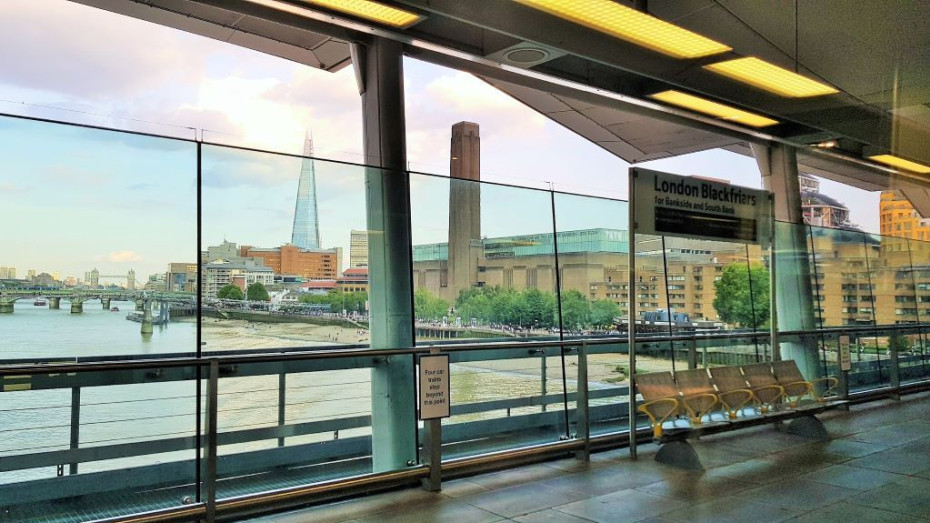
London By Train: What's good to know
Tips and info when taking trains to and from Europe's largest city, by a Londoner who always takes the easiest route!
Share
Welcome to the place I have always called home!
When railways began to be the primary form of long-distance public transport, London was at the time, the world’s largest city, so the upheaval and costs that would have incurred by the creation of a dominant city centre rail station, were too prohibitive.
As a result central London is ringed by 11 stations and at each of them (except London Bridge and St Pancras), all or most of the long-distance trains which use them, reverse direction to head back out of the city.
Therefore when travelling between a main London station and a location in the city centre, the fastest and often cheapest option is to use the Underground; the link connects to the official Underground map, which also shows the route of the Elizabeth line.
But taking the Underground often isn’t the easiest way to go, particularly if you’ll be arriving at a London station with luggage, strollers, young children or anything else that will be tricky to manoeuvre up and down escalators and staircases.
Hence the guide to taking the alternatives to the Underground.
Though three universal things worth knowing are:
- The access to and from the Underground trains and both the Elizabeth line and Thameslink trains. is always through a line of ticket gates, but one wider gate through which luggage etc can be wheeled through is always available.
These wider gates are also typically staffed. - Tickets for end-to-end journeys which cross London typically include the cross-city transfer, you won't normally have to purchase separate tickets for the part of the journey by Underground, but such tickets can't be used on buses.
- On the signage at the Underground stations within central London, the direction of the trains leaving from each platform is designated by the use of compass points and not the final destinations of the trains.
So trains heading to destinations north of the city centre are northbound trains and those heading west are wetsbound trains etc.
Although this doesn't always make perfect sense; For example, 'northbound' Piccadilly line trains heading to destinations in north London actually spend much of their route travelling west to east across the city center.
So it can be a good idea to take your time at stations and look twice, so that you also see the list of stations that the trains heading in that direction, will be calling at.
How to use the larger London stations
These are the stations from which the trains provide access to multiple holiday destinations and tourist attractions.
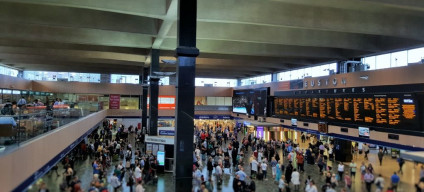
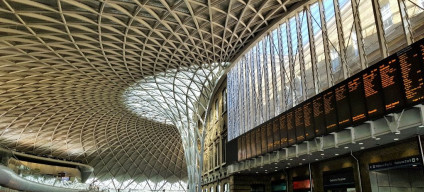
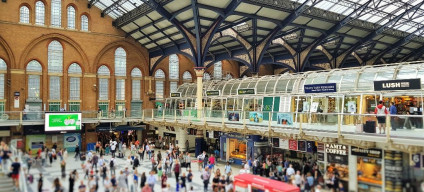
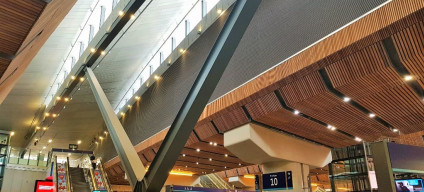

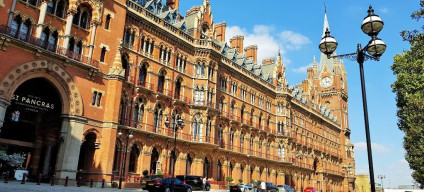
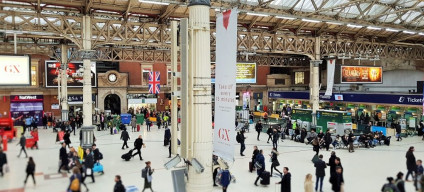
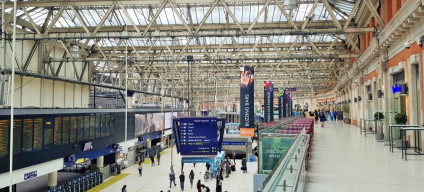
Station to Station transfers
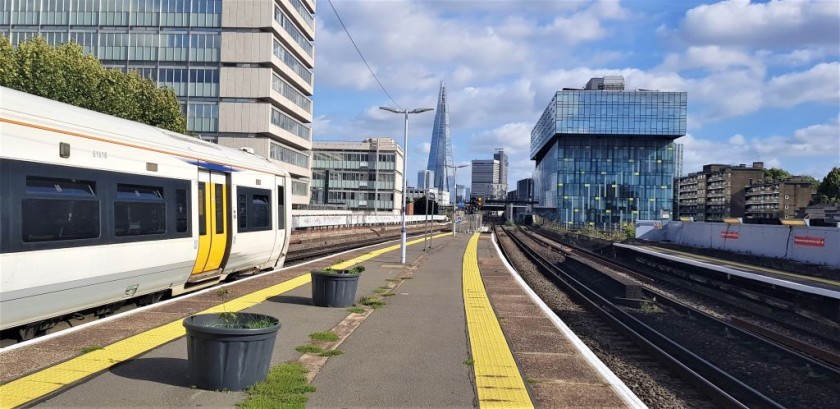
Note the advice for travel to a station can vary from that on how to travel from a station, due to variations in the optimum route in each direction. For example, the suggestions below whenever possible, don't include any transfers which involve crossing a street from a station.
Also the included transfers are those which facilitate long-distance journeys by train that involve cross-London connections, so the stations which primarily serve shorter-distance and commuter routes such as Cannon Street, Fenchurch Street and Marylebone have been excluded.
At weekends the Underground lines and both the Elizabeth line and Thameslink trains can be impacted by construction work, those affecting the Underground and Elizabeth line trains can be looked up here, while those impacting the Thameslink trains, can be found here.
Click the button below for the guides to making the transfers from and to each station:
The different types of Underground lines:
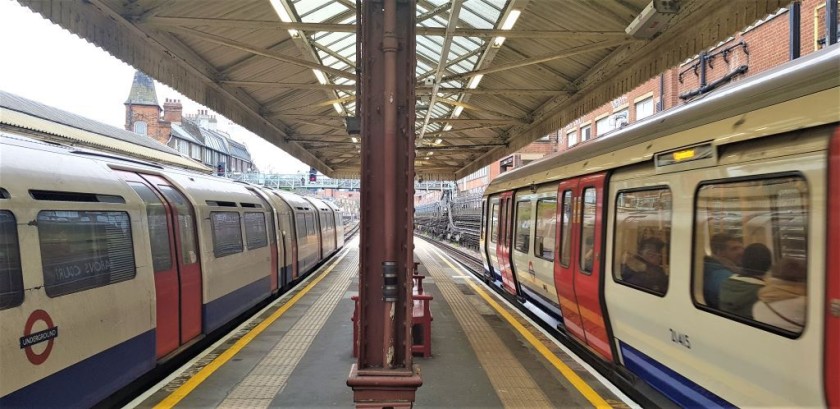
Worth knowing when taking a rail journey to and from the UK’s capital city is that there are two different types of Underground lines:
- the ‘Tube’ lines, and
- the sub-surface lines.
The Tube lines:
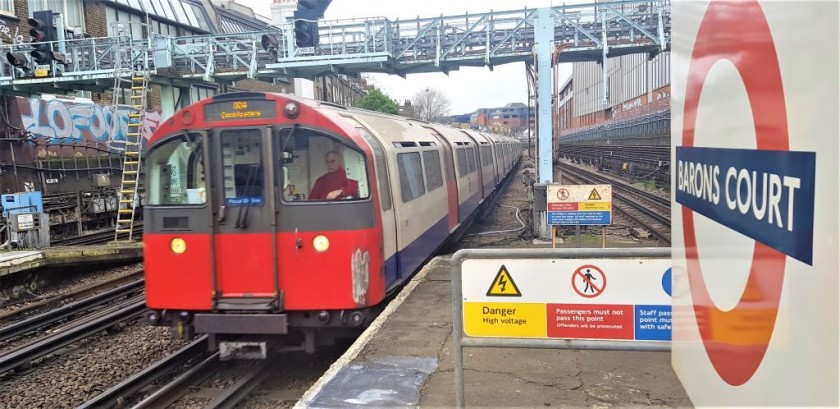
These are the Underground lines which cross the city’s central area and use tunnels deep beneath the streets.
Because they’re buried far down under the city, the access to and from the parts of the stations that these trains use, typically involves taking long escalators, though some of the lesser used stops only have elevators.
Though all of the Tube' stations at the mainline stations are accessed by escalators and some have lift (elevator) access too.
Though at a few locations, short flights of stairs provide the link between the escalators and the trains.
This is the situation when taking:
- the Bakerloo line to and from Charing Cross and Marylebone and Waterloo
- the Central line to and from Liverpool Street
- the Northern line to and from Charing Cross and Waterloo and when taking the Charing + branch at Euston
Though be warned that step-free access by lift (elevator) between street level and the platforms, from which the trains can be boarded, is comparatively rare at central Underground stations.
The tube lines are:
- the Bakerloo which serves Charing Cross* and Marylebone* and Paddington and Waterloo*
- the Central which serves Liverpool Street
- the Jubilee which serves London Bridge* and Waterloo*
- the Northern, which serves Charing Cross* and Euston* and King's Cross and London Bridge* and St Pancras and Waterloo*
- the Piccadilly, which serves King's Cross and St Pancras
- the Victoria which serves Euston* and King's Cross and St Pancras and Victoria
- the Waterloo & City which serves Waterloo*.
*= the tube lines are the only type of Underground line available at these central London railway stations.
Aside from the Piccadilly, the tube trains don’t have luggage racks, though what are becoming more common are spaces by the train doors with flip-up seats, which are ideal for accommodating large bags, folded pushchairs etc; when they are not full of standing passengers who have squeezed onto the trains.
the Sub-Surface lines:
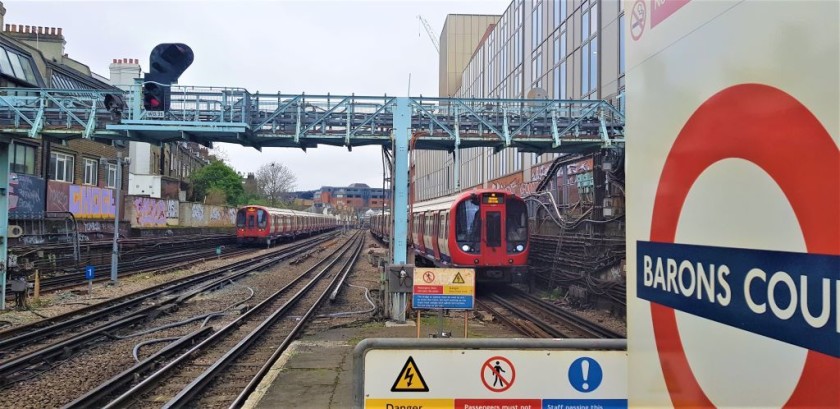
The other Underground trains are similar to full size commuter trains and they use a railway which loops around the city in a tunnel just below street level; hence they known as the sub-surface trains.
The Circle, District, Hammersmith & City and Metropolitan lines use this tunnel.
On the northern edge of central London, the Circle, Hammersmith & City and Metropolitan lines all serve Liverpool Street; King's Cross and St Pancras stations directly; while Euston Square station is a short walk from Euston.
Both the Circle and Hammersmith & City lines also serve Paddington
Towards the southern side of central London the Circle and District Lines serve Cannon St, Blackfriars and Victoria.
Accessing and boarding these trains
Because these lines are not far below the surface, staircases provide most of the access to the trains at the stations.
Though lifts (elevators) are becoming more common - They’re available when accessing the trains on these lines at Cannon Street, King’s Cross St Pancras, Paddington (not the eastbound District line) and Victoria railway stations.
A feature to be aware of when using these different sub-surface lines is that they share tracks, so trains on different lines follow each other in and out of the platforms at the stations.
Meaning that, for example, when taking the Underground from Kings Cross to Paddington you need to avoid boarding a Metropolitan Line train; and when heading to Paddington from Victoria you need to take a Circle Line train.
Though on other journeys such as Liverpool Street ↔ King's Cross, because the lines share the track, it doesn't matter which specific 'line' is taken, instead it's possible to simply hop on the first train to arrive.
Also these sub-surface trains operate less frequently than the Tube trains.
You may have to wait 10 mins or more if you need to take a specific service such as a Circle line train Victoria to Liverpool Street or Paddington.
Avoiding the Tube lines when arriving in London by train:
Transferring to the tube lines, particularly the Central, Jubilee, Northern, Piccadilly and Victoria lines when arriving by train in London is often best avoided.
The tube stations at the mainline stations tend to be exceptionally busy and the trains are usually crowded with the people they’ve picked up outside the city centre.
Plus accessing the trains can take a while with multiple escalators and corridors to be negotiated, in the summer temperatures rise and neither the tube trains, or the stations, have air-conditioning.
However, the center of London is not devoid of conventional railway lines and now there are multiple rail options, including the Elizabeth line, which can be highly useful alternatives to taking the Underground; Particularly as Contactless payments can also be used to travel by these mainline trains in the city centre.
Also taking the bus can be the easiest way to go, especially when travelling with luggage and children, etc.
How the ticketing works in London
Whether you will be taking:
- the Underground
- the Overground
- the DLR
- the Elizabeth Line
- Thameslink trains
- the trains between Charing Cross and London Bridge stations
- all other rail journeys within the London fare zones
it's usually (much) cheaper; and often much simper, if you don't buy a ticket(s).
That's because all of the ticket gates and station entrances / exits within the London Fare zone have 'readers' which enable contactless payment.
Regardless of whether you are resident in the UK, or are visiting, there are three methods of using Contactless:
- A payment app on a mobile device, including your bank's contactless payment app, or the likes of Google Pay, Apple Pay, or Samsung Pay.
- A debit / credit card as long as it has the contactless symbol (some non-UK cards with the symbol are also an exception - particularly when visiting from the Canada. the USA and The Netherlands, so it's worth confirming with your bank prior to arrival in London).
- An Oyster card (you touch in and out as you do when using Contactless).
Good to know about using Contactless
- The system works by touching in and out. At stations without ticket gates you need to use the 'readers' with an Oyster yellow symbol by the station entrance / exit, even when not using an Oyster card. On the regular red buses you also need to use the Oyster card readers regardless.
- When using bank cards, take care to use the same card when touching out at the end of a journey, as you did when touching in at the start.
- You have to pay with Contactless on the regular red buses, you cannot pay with cash.
- At some interchange stations you will see readers which have a pink Oyster symbol instead of a yellow symbol - If you will be taking a multi-train route, but won't be travelling through Zone 1 in the city centre, you can save money on the journey fare by 'touching / tapping' a card / phone on these pink machines.
- When travelling by the Underground, Overground, DLR or Elizabeth line, you can save 10 - 20p per journey by paying with a banking app / card instead of an Oyster card.
- There are daily price caps / maximum daily charges, so you don't have to worry about the cost per day when taking multiple daily journeys within the Greater London area by public transport.
The max prices are the same regardless of what contactless payment be used, but they differ according to how many fare zones you travel through in a single day.*
Note that when travelling between destinations on opposite sides of central London, you will save money by travelling around Zone 1, than when travelling across it.
In general the price caps begin to apply when taking four of more journeys in a day.
Using Oyster cards
The key difference between using Oyster Cards and other forms of contactless payments, is that Oyster Cards need to be especially pre-loaded with funds before you take a journey, but using using a bank payment app / card is Pay As You Go.
So when using a banking payment app / card, the charge will be deducted from an account at the end of each journey (until you reach the daily price cap)
You can add money to an Oyster card at ticket counters and by using ticket machines at stations within the Greater London area, so you also need to ensure you still have sufficient funds loaded on to an Oyster card when taking a journey.
Then at the end of the visit to London, if you have registered the card, you can claim back any unused credit.
So using an Oyster Card is tad more awkward than the other forms of Contactless payment, and for journeys by the Underground, Overground, DLR or Elizabeth line, it is also slightly more expensive.
Hence when UK residents visit London, touching in an out with bank cards or a payment app on a phone, is now the best method of paying for journeys by public transport in the Greater London area.
However, for international visitors to London, an Oyster card can be the better option, if these factors apply:
- If your bank card is a type that can't be used for contactless payments on the card readers at stations.
- If a bank will impose a currency exchange fee on every single card payment, so check which charges your bank will apply on international transactions, before you set off.
This can tip the balance towards the Oyster Card, as you will likely only be paying such currency exchange fees / charges once or twice per trip to add funds to it.
When visiting London there are two Oyster card options:
- The Visitor Oyster Card, which needs to be purchased before travelling to the UK - you need to allow time for the card to be shipped to your address.
The Visitor Oyster Card also gives some access to discounts, (typically 10-20%) on a comparatively small range of restaurant charges, gift shops at certain attractions, and a few museum admission prices. - Purchasing a standard Oyster Card when you are in London - Though you will be charged £7 for the card.
Note that Oyster cards cannot be purchased from the National Rail (non Underground) ticket machines or desks at the major stations in London.
Travelcards vs Contactless
A Travelcard is in effect a travel pass for use on any of the public transport options within the London fare zones.
It was established as a money-saving option compared to buying separate tickets per journey, before Contactless payments came into existence.
As the max cost per day of using Contactless is cheaper than using Travelcards, most visitors to London now don't need to be aware of them.
However, there is a significant exception, which is that Travelcards are available for 7 days of consecutive travel.
The 7 day card is priced so that the purchaser in effect pays for five days of travel, but then has two free additional days.
So if you will be spending six or seven days in London, and taking more than four (maybe just three) journeys per day, the 7 Day Travelcard becomes a cheaper option than travelling Contactless.
Once you have the card, you can have the freedom to travel without the need to top-up, and it can be purchased at any station in London in one transaction - so it can be a money saver and it keeps things simple.
You can either purchase a physical card which looks like a train ticket - these need to be inserted into ticket gates - it will pop up out of the slot, and when you pick it up the gates will open.
At stations without ticket gates you simply walk on on off the platform.
Or you can load the 7 Day Travelcard on to any type of Oyster card.
The 7 Day Travelcards are also available at a 50% discount for children aged 5 - 15, those aged 4 and under travel for free.
Buying tickets
For journeys by
- the Underground,
- the Elizabeth Line (see below)
- the DLR
- any journey by regular trains in within the London fare zones
making a Contactless payment is cheaper than buying a ticket from a station counter or machine - the price difference is usually at least 50%!
Hence it's best avoided when visiting London, so the recommendation is: - add a payment app to your mobile device (and check that you won't incur charges /fees when making an international visit to London); or
- Verify that you can use bank cards to make contactless payments without incurring additional fees / charges; or
- get an Oyster Card.
Though if you will be only making a couple of journeys such as from a station to a hotel, then paying the extra cost of buying a ticket, may keep things simple.
The only other occasions when buying tickets is the way to go, is if you will be travelling to an attraction within the the London fare zones which offers entry discounts to those who travel to the attraction with National Rail tickets.
So buying a ticket to obtain the discount, instead of using contactless + paying the full admission price, can be an overall money saver when visiting the likes of:
- Hampton Court Palace
- The Cutty Sark in Greenwich
- Kew Gardens
- The Wembley Stadium Tour.
Travelling to destinations outside the London area
For most rail journeys beyond the London fare zones contactless payments can't be used - Though a key exception to this 'rule' are journeys between the London fare zones and Gatwick Airport.
Though Pay As You Go has been extended for travel to and from more stationsin south-east England.
So for any other journey to/from destinations outside London, you will need to buy a ticket online, or from a ticket machine* or a ticket counter*.
*= not at Underground stations.
So if your journey will be commencing at station in the London suburbs, to a destination in south-east England such as Brighton, Cambridge, Hastings, Oxford, Portsmouth, or the Kent Coast, don't touch in with a bank card at the start of a journey.
Travelling with children
Children aged 10 and under travel for free on Underground, the DLR, the Overground and the Elizabeth line when accompanied by a fare paying adult - and they can also travel for free on the regular, red bus services.
Though at the rail stations you will need to ask the staff to open the gates, while not forgetting that the accompanying adults using Contactless need to touch in an out.
Children aged 11-15 can travel at a 50% discount when travelling on the Underground, the DLR, the Overground, the Elizabeth line and the regular London buses.
However children aged 5-15 (and not 11-15) travel at a 50% discount on the other National Rail services in the London area, so children aged 5 - 10 require tickets for any train journey not by the Elizabeth line or the Overground.
If you will be visiting London with children aged 11-15, the two ticket options per child are:
1: Using a Visitor Oyster Card
Buy a Visitor Oyster Card, which needs to be purchased before travelling to London - you need to allow time for the card to be shipped to your address.
UK residents can also buy these cards.
The child then needs to accompany you (with proof of age) to a staffed ticket counter so that a member of staff can then apply a half-fare rate to the card
This can be done at most Tube stations, a TFL Visitor Centre. or at the ticket counters on the main concourse at Victoria station - where the Gatwick Express trains will arrive.
The reasoning for this convoluted procedure is that children aged 11-15 living in London have to use locally issued photo cards.
Note that adults accompanying the child aged 11-15 on the journeys don't have to use Visitor Oyster Cards, they can instead use the other types of Contactless payment.
2: Using a Travelcard at the child rate
If you will be taking more than a couple of journeys in a day, the other option is to purchase a Travelcard at the discounted rate of 50%.
A key difference with using the Visitor Oyster Card is that at ticket gates the Travelcards needs to be inserted, they can't just touch in and out.
Again the Adults accompanying the child / children can travel with Contactless.
Or if your travel party will be spending six or seven days in London, and taking more than four (maybe just three) journeys per day, the 7 Day Travelcard becomes a cheaper option than travelling Contactless and a 50% discount can be applied to children aged 5 - 15.
If you will be in London for a shorter period of time and travelling with children aged 5 to 10 on the other National Rail services (not the Overground or the Elizabeth line), the best option is likely to be a ticket for the journey by such trains - at a 50% discount.
Then the child can travel for free when travelling on by the Underground, the DLR, the Overground, the Elizabeth line, or the regular red buses.
Using rail tickets to obtain 2-for-1 entry to visitor attractions:
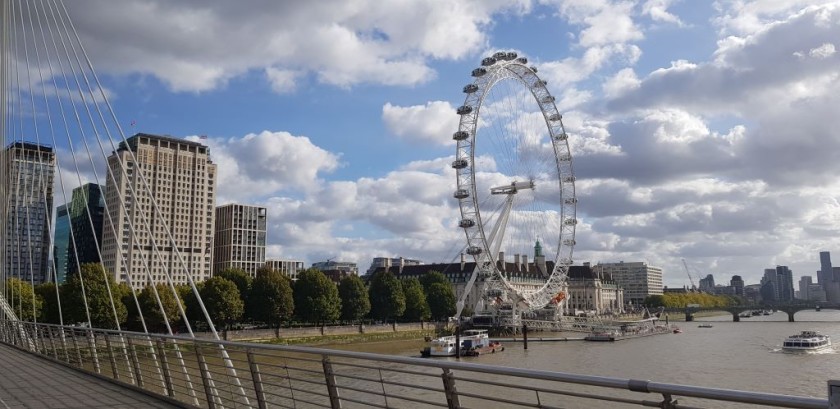
National Rail, which has overall responsibility for how the trains are managed in Britain, has teamed up with a swathe of tourist attractions for a promotion which allows two entry tickets for the price of one when travelling to and from them by train.
How it typically works is:
- You can look for which attractions and guided tours are members of the scheme on the National Rail website.
- Having chosen an attraction you can then see how to book the special promotional tickets or voucher; when needed you can find promo codes on the dedicated page for each attraction on the National Rail Website.
- On the online booking page of the attraction you should see an option which corresponds to 'National Rail - Two for One offer'.
- Book your attraction tickets or voucher.
- On arrival at the attraction you present your attraction tickets and rail tickets to gain entry.
The offers are available to visitors to the UK as well as residents, so they can be a great way to save money when on a holiday.
Though what's good to know is:
- You need to present either the outward or return part of a national rail ticket to gain entry, along with your attraction tickets; So Oyster Cards and other Contactless payments, or Travelcards can't be used for the rail journey!
- The ticket machines at stations will retain one-way tickets, hence return tickets are a must - and if possible avoid putting your outward tickets through the machine, by asking the staff to open the gates/barriers.
- The two people entering the attraction on the 2-for-1 offer will both need separate rail tickets.
- The type of rail ticket, how much you paid for it and the distance travelled all don't matter, any pair of return rail tickets will suffice.
- If you have one, you can use Railcards to book the rail tickets.
- Rail tickets are available as an alternative to Oyster cards when travelling between any two National Rail stations in the Greater London area; a National Rail station is any station not solely served by the Underground or DLR, so it includes stations solely served by the Overground or Elizabeth Line trains.
Therefore you can buy return rail tickets to a central London station, or to a station located by an attraction, from another station in the London area.
However before booking the 2-for-1 offers on the attraction websites, carefully check how much you will be saving by only paying one entrance fee, compared to the costs of booking two rail tickets.
If you look up the journey on the National Rail website you'll get a good idea of the train ticket costs.
It's likely you won't be able to claim a refund on the attraction tickets, if you then decide not to go ahead, because the rail tickets + the 2-for-1 offer won't save you money.
Though it's highly likely you will make a substantial overall saving.
But if you have already booked two return rail tickets and then find an attraction(s) that you want to visit, go ahead and book the 2-for-1 offer, as you'll then be certain of saving money!
Where can you go and what can you see
The full list of tourist attractions participating in the scheme can be found on the National Rail website.
Popular attractions in central London include:
- Westminster Abbey
- St Paul's cathedral
- the London Transport Museum
- The London Eye
- The Tower Of London (certain times of year only)
Attractions in the wider London area, with easy access from local rail stations, include:
Attractions which are an easy day trip from London include:
- The Bluebell Railway; very easy connection at East Grinstead station.
- Steam - The Museum of the Great Western Railway
- There's a clutch of attractions in Brighton including:
the charming Toy and Model Museum and The Royal Pavilion and Sea Life Brighton - Chessington World Of Adventures which is walkable from Chessington South station, which has trains from London Waterloo.
- Thorpe Park which can be accessed by taking a train from London Waterloo to Staines and then connecting into a bus service.
- Legoland Windsor which can be accessed by taking buses from central Windsor that offer straightforward connections with trains from London Paddington and trains from London Waterloo.
Though carefully check the full details for the amusement park offers as they exclude certain dates and periods of time, which tend to coincide with school holidays.
To London's most popular tourist attractions from the major stations
By train to and from London airports
Significant improvements have been made to the rail links at London's airports in recent years;
- the number of rail connections between Gatwick and central London stations has more than doubled, thanks to the expansion of the Thameslink network;
- there has been the opening of the Elizabeth line and its new connection to Heathrow;
- plus there's the new DART people mover which now links Luton Airport's passenger terminal with its station.
City
City Airport is directly served by a people mover system named the DLR which calls at the airport station every 5 to 15 minutes.
The DLR route to/from the airport doesn't serve central London, but step-free connections by escalator and lifts are available with the Jubilee line of the Underground at Canning Town station and with the Central and Elizabeth lines at Stratford.
Access to and from any London station can be looked up on the TfL journey planner.
Stratford station also has direct trains to and from a swathe of more distant destinations in Essex, Suffolk and Norfolk, including Southend-on-Sea, Colchester, Ipswich and Norwich.
Gatwick
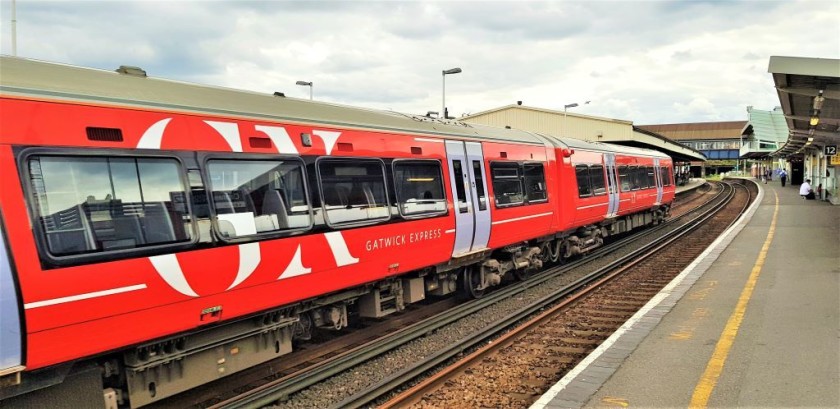
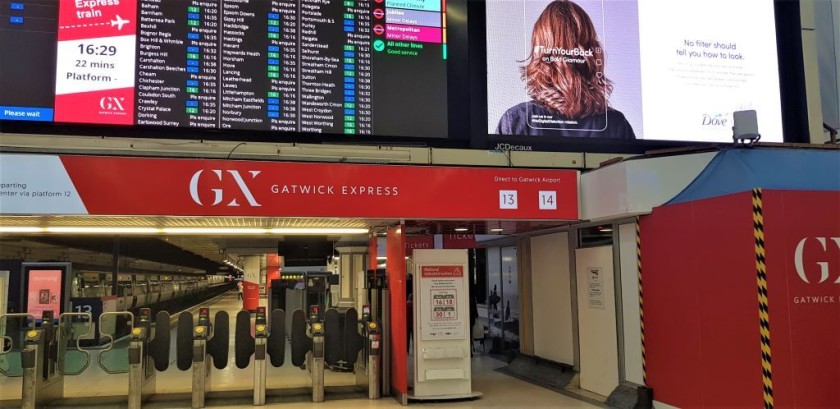
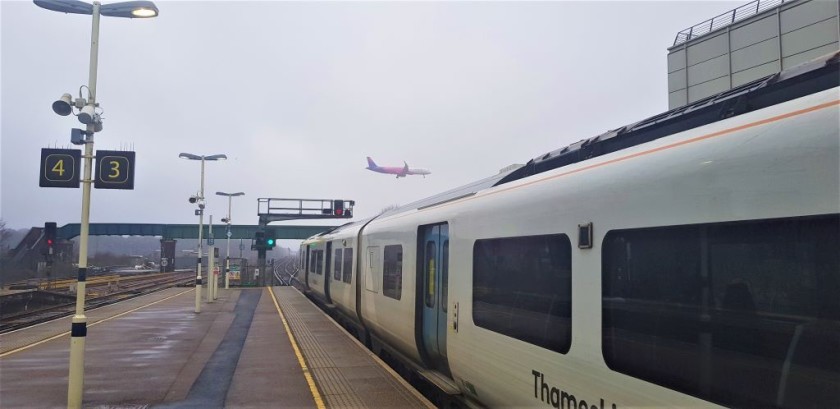
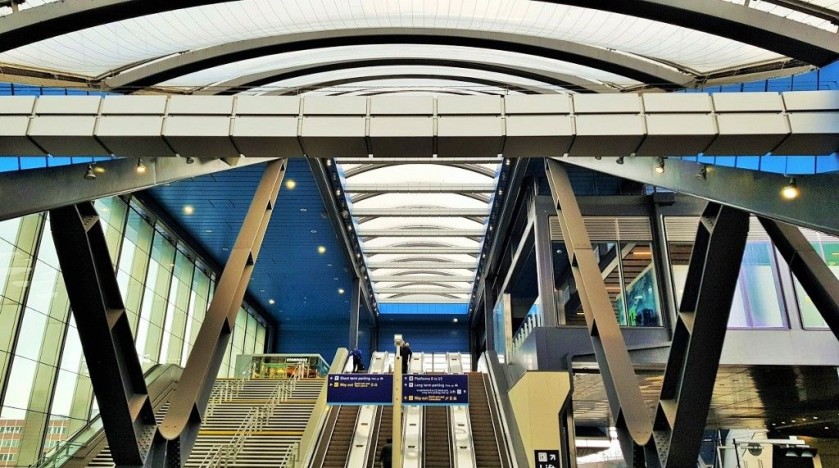
Gatwick Airport station is directly linked to the South Terminal and is connected to the North Terminal by a free people mover.
If you will be taking the train to central London it's a good idea to look up the location of your ultimate end destination in the city centre to get an idea of whether heading to Victoria station, or a station served by the Thameslink trains, will be the best option.
Don't assume that taking the Gatwick Express and then a taxi or Underground will be the quickest or easiest route.
The ticket gates at Gatwick are equipped with Pay As You Go readers which accept bank cards, credit cards, Google Pay, Apple pay and Oyster Cards, so you can use these cards to travel to and from the airport.
However, the amount of money deducted from the cards will match the ticket costs, so you won't save money by using Oyster.
Though you will save likely save time, if you will be heading to London there's no need to queue to use a ticket counter or ticket machine.
taking the Gatwick Express
Gatwick Express trains share the route to and from London Victoria station with Southern trains, but they are more expensive and therefore require specific tickets.
Two factors set them apart from the Southern trains:
- They have additional luggage storage.
- They are faster because they are non-stop.
The journey time is scheduled to be 31 minutes, but because they share the same busy tracks as the Southern trains, they are typically only two minutes faster in comparison.
The biggest plus point of taking the Gatwick Express over the Southern trains, used to be that the only stations served by the Gatwick Express trains were Gatwick and Victoria.
When that was the case, they were quieter than the Southern services, so seats could be guaranteed on any departure.
However, the Gatwick Express is now typically a London Victoria <> Brighton service, which happens to call at the airport.
So when heading to London, on arrival at the airport station, the Gatwick Express trains can be busy with travellers who have already boarded in Brighton.
Also because the Gatwick Express trains typically no longer commence their journeys at the airport, the train will only spend a minute at the platform, so there's typically no early boarding available of a near empty train with guaranteed space on the luggage racks.
At Victoria, the Gatwick Express trains share the station with the Southern services, though they have a dedicated pair of platforms /tracks.
These platforms also have a dedicated taxi rank, so when taking a taxi to Victoria station, tell the driver if you want to take the Gatwick Express.
taking the Southern trains
Southern Railway offers a more frequent and typically cheaper alternative for journeys between Gatwick Airport and London Victoria station than the Gatwick Express.
Southern also provides the train service between the airport and the major interchange station of Clapham Junction where connections are available to a swathe of locations in west and north London including Hampstead, Putney, Richmond, Shepherd's Bush and Wimbledon.
taking the Thameslink trains
Up to 8 Thameslink trains per hour connect Gatwick Airport to multiple stations in central London:
- London Bridge; connect for Charing Cross and Waterloo East,
- Blackfriars, for the South Bank arts complex and Tate Modern,
- City Thameslink for St Pauls; this station is closed on Sundays,
- Farringdon connect with the Elizabeth line for Heathrow Airport, Bond Street, Tottenham Court Road, Liverpool Street and Paddington,
- St Pancras Thameslink which serves St Pancras International station and King's Cross station.
All Thameslink trains from Gatwick call at all of these stations before heading on to destinations to the north of London.
One or two trains per hour link the airport to Cambridge and Peterborough.
Up to four trains per hour go to Bedford and these trains all call at the station which serves Luton Airport.
So when heading to central London by Thameslink trains board trains heading to Bedford, Cambridge and Peterborough.
Heathrow
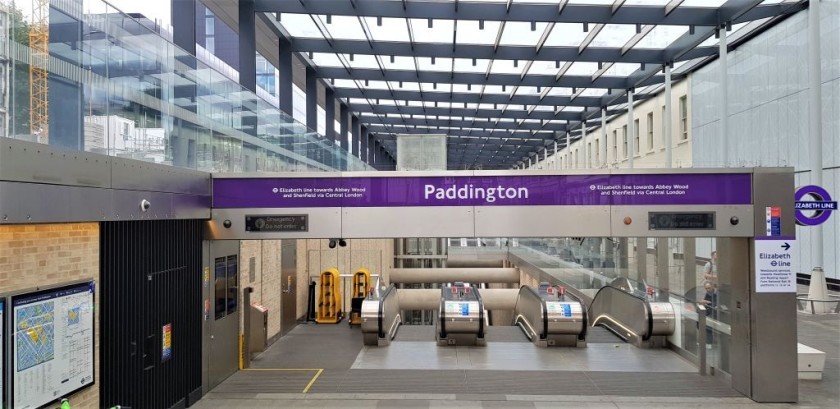
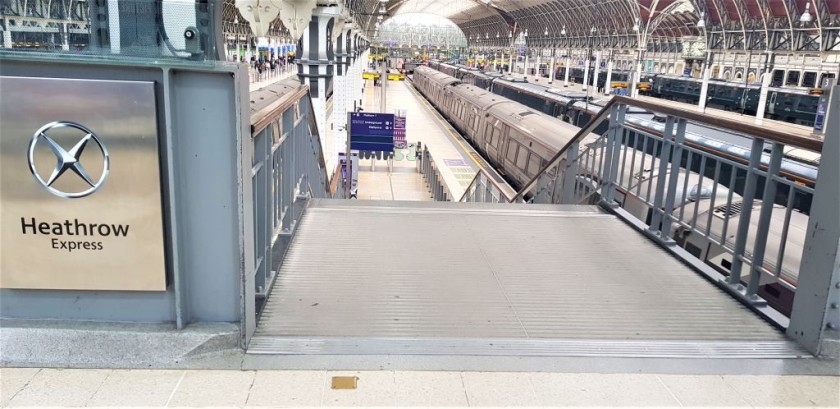

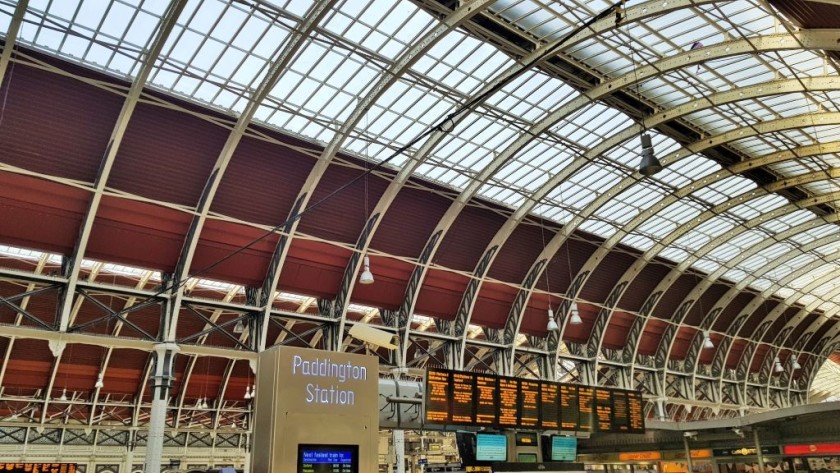
Britain's busiest international airport has three stations at:
- Terminals 2 and 3
- Terminal 4
- Terminal 5
which are all used by the three different train services which connect Heathrow to central London by train
All of the trains to and from Heathrow call at the station linked to Terminals 2 and 3 - though if you'll be taking the Piccadilly line to Terminals 2 and 3, it's quicker to take a train heading on to Terminal 5.
However, all trains also call at either the station at Terminal 4, OR at the station at Terminal 5 - so particularly when heading to the airport, take care to board the correct train.
The current operating situation and planned works on the Elizabeth line and Piccadilly line can be looked up here.
The current operating situation and planned works on the Heathrow Express can be looked up here.
Heathrow is in the Transport For London zone 6, so Contactless and the usual Oyster Card rates are valid on Piccadilly line train - However, other fares apply to the Elizabeth Line.
Comparing the three train services:
Ticket costs:
- the Piccadilly line from any central London station = £5.60 with Contactless; £6.70 with a ticket
- the Elizabeth line from Paddington station = £12:20; Contactless and tickets
- the Elizabeth line from other stations in central London = £13.30 with Contactless £15.80 without an Oyster Card
- the Heathrow Express = £15 if booked in Advance online; £25 if booked last minute at the station, the Contactless rate is also £25.
Though the child rates differ: Heathrow Express = 15 and under travel free; Elizabeth line and Piccadilly line = 10 and under travel free, 11 to 15 at 50%,
Contactless = touching in and out of ticket gates with bank cards, apps and Oyster cards
Railcard holders can obtain the usual discounted rates on both the Heathrow Express and the Elizabeth line.
Journey times to and from Heathrow Terminals 2 and 3 station:
- the Piccadilly line to/from Gloucester Road (its closest station to Paddington) = 42 mins
- the Elizabeth line to/from Paddington = 27 mins
- the Heathrow Express to/from Paddington = 16 mins
The trains:
- the Piccadilly line = limited dedicated luggage space, no Wifi, not air conditioned
- the Elizabeth line to/from Paddington = no dedicated luggage space, Wifi, air conditioning
- the Heathrow Express to/from Paddington = lots of large luggage space, WiFi, on board entertainment, air conditioning
Central London stations:
- the Piccadilly line = multiple stations - Those which are particularly distant from Elizabeth line stations include Knightsbridge, South Kensington and Earl's Court; A step-free easy interchange is available with District line trains to/from central London at Baron's Court.
- the Elizabeth line = Paddington (access to/from the trains is by escalators and elevators) and Bond Street, Tottenham Court Road, Farringdon and Liverpool Street
- the Heathrow Express = Paddington (access to/from the trains is step-free from the man concourse).
Taking the Elizabeth line:
There are typically 4 x trains per hour which take a Abbey Wood - Canary Wharf ↔ Terminal 4 route.
There are typically 2 x trains per hour which take a Shenfield - Stratford ↔ Terminal 5 route.
All trains call at the station which serves Heathrow Terminals 2 and 3, and also at all central London stations, which are:
- Paddington journey time = 34mins, connect for Bakerloo, Circle and Hammersmith & City lines.
- Bond Street journey time = 39mins, connect for Central and Jubilee lines.
- Tottenham Court Road journey time = 41mins, connect for the Northern line.
- Farringdon journey time = 44mins, connect for the Circle, Hammersmith & City and Metropolitan lines, plus Thameslink trains to Brighton, Cambridge, Gatwick Airport and Luton Airport
- Liverpool Street station.
The first train to the airport from the central London stations arrives at around 06:30; and the final train of the day from those stations arrives at around 23:45.
From the airport the first train of the day to the central London stations typically departs at around 05:20 and the final train departs at around 23:05.
Taking the Heathrow Express:
There are typically trains every 15 minutes which travel non stop in both directions between the station at Heathrow Terminals 2 & 3 and Paddington station, with trains every 30 mins from and to both Terminals 4 and 5.
At Paddington the taxi rank is closer to the part of the station used by the Heathrow Express than the Elizabeth line.
When arriving at Paddington, the step free route is by exiting on to the main concourse and turning to the left.
The first and last trains arrive at depart and from the airport at around 05:05; and the final trains of the day arrive at, and depart from Paddington at around 00:10.
Taking the Piccadilly line:
The Piccadilly line provides a direct link between Heathrow and many locations in central London not served by the Elizabeth line.
So despite its relative lack of speed, the journey between Heathrow and Piccadilly Circus station is scheduled to take 48m mins, it can be the best option when travelling from and to the likes of Earls Court, the museums district, Knightsbridge and Covent Garden.
The first train of the day towards central London departs at around 05:10 and the final train of the day is at around 23:45.
When travelling from central London, the first train of the day arrives in the airport at around 06:35.
Between the main London stations and Heathrow:
To Euston station for trains to Birmingham; Glasgow; Liverpool and Manchester.
Take the Elizabeth line to Tottenham Court Road and connect there for a northbound Northern line train.
To King's Cross station for trains to Edinburgh; Leeds; Newcastle and York.
AND
To St Pancras International station for trains to Amsterdam, Brussels, Paris, Canterbury, the Kent coast, Derby. Leicester, Sheffield and Nottingham.
Take the Elizabeth line to Farringdon and connect for a northbound Thameslink train to St Pancras Thameslink station, or when that isn't an option, go direct on the Piccadilly line.
To Liverpool Street station for trains to Ipswich and Norwich.
Take the Elizabeth line direct to Liverpool Street.
To London Bridge station for trains to Canterbury, Hastings and the Kent coast.
Take the Elizabeth line to Farringdon and connect for a southbound Thameslink train; though not all trains from Farringdon go to London Bridge.
Luton

The DART people mover has commenced service between the Luton airport terminal and Luton Airport Parkway station.
Two train services are available between central London and Luton Airport Parkway:
- Trains operated by Thameslink
- Trains branded 'Luton Airport Express' which are operated by EMR
Travelling between Luton Airport and St Pancras by train
Both the Luton Airport Express trains and the Thameslink trains connect Luton Airport with St Pancras International station which is located on the northern edge of central London.
In St Pancrcas International both train services use the north end of the main terminal, with the Luton Airport Express trains on the level above, and the Thameslink trains on the level below, the main concourse.
So it doesn't matter which train service you take regarding how easy it is to transfer to and from taxis, the Underground. or the adjacent King's Cross station.
Though the Luton Airport Express services are non-stop, so have a journey time of only 23 minutes; typically 9 minutes quicker than the fastest Thameslink trains.
The other plus of taking the 'Luton Airport Express trains is that EMR offers discounted Advance tickets, but Thameslink doesn't.
So if you book ahead, the tickets for a journey from and to St Pancras can be over 75% less than taking the Thameslink trains.
For this reason if you book a ticket for travel with EMR you can't then opt to travel on a Thameslink train instead; and vice versa, tickets marked Thameslink stations can't be used to travel by the Luton Airport Express.
These Advance tickets are a particularly good option when heading to the airport by the Luton Airport Express, as they can only be used on the specific departure you select when booking.
So if you book an Advance ticket from the airport and then experience a flight delay, you will have to buy another ticket at the airport.
When booking last minute at the station, the same price is charged on the Airport Express and the Thameslink trains, so if you will be buying tickets at St Pancras International or at Luton Airport Parkway stations just prior to boarding, check which service will be the next to depart and book accordingly.
Oyster Cards can't be used to travel between Luton Airport Parkway and central London.
Though the other two key differences between taking a Luton Airport Express train or a Thameslink service are
- the frequency, and
- the the timings of the first and last trains:
- the Luton Airport Express typically departs every 30mins until 21:00 and hourly afterwards.
- Four fast Thameslink trains per hour are usually available; so when heading to London from the airport these fast Thameslink services are the trains heading to Brighton and Three Bridges - avoid the trains heading to Rainham as they call at all intermediate stations.
- the final Airport Express train to St Pancras typically departs Luton Airport Parkway before 23:30 on Monday to Friday and before 22:30 on Sat/Sun, but Thameslink trains are typically available 24 hrs; though the service is only hourly overnight.
Travelling between Luton Airport and central London by train
A plus of taking the Thameslink trains to and from Luton Airport is that they cross central London, so call at multiple stations in addition to St Pancras International.
They are:
- Farringdon connect with the Elizabeth line for Heathrow Airport, Bond Street, Tottenham Court Road, Liverpool Street and Paddington.
- City Thameslink for St Pauls; this station is closed on Sundays,
- Blackfriars, for the South Bank arts complex and Tate Modern,
- London Bridge; connect for Charing Cross and Waterloo East.
When the usual service is operating target the faster trains:
- to the airport, they are the trains typically heading to Bedford,
- from the airport, they are the trains typically heading to Brighton or Three Bridges or East Grinstead.
Stansted
The Stansted Express is the rail link between the airport and central London, two trains per hour travel to and from Liverpool Street station in a journey time of around 45 - 50 minutes; the airport is some distance from the city.
The trains also call at Tottenham Hale station where a step-free transfer with the Victoria line of the Underground is available; Liverpool Street is located towards the eastern edge of the city centre, but the Victoria line serves the West End.
Though a new, easier route is available when travelling between Stansted and the Oxford Circus area, as Elizabeth line trains provide a connection with Liverpool Street.
The first Stansted Express train of the day arrives in the airport at around 05:40 and the final departure of the day is typically at 00:30.
Which station for popular day trip destinations?
To Bath from Paddington
To Bicester from Marylebone; take trains heading to Oxford
To Brighton from St Pancras; Blackfriars and London Bridge by Thameslink trains; and from Victoria by Southern trains
To Cambridge from Kings Cross (fastest) and also from Blackfriars, London Bridge and Liverpool Street
To Canterbury from St Pancras (by hi-speed trains), other trains also depart from Charing Cross, London Bridge and Victoria
To Leeds Castle by taking trains to Bearsted from Victoria
To Oxford from Paddington and from Marylebone
To Salisbury; for Stonehenge from Waterloo
To Windsor from Paddington (faster but change of train at Slough required); from Waterloo (slower, but direct)
To Warwick from Marylebone
To Winchester from Waterloo
Please support ShowMeTheJourney
This second version of ShowMeTheJourney is exciting and new, so we are genuinely thrilled that you are here and reading this, but we also need your help.
We’re striving not to let anything get in the way of providing the most useful service possible, hence a facility has been set up with DonorBox which can be used to support the running costs and make improvements.
Instead of advertising or paywalls, your financial support will make a positive difference to delivering an enhanced service, as there’s a lot of ideas which we want to make happen.
So if you have found the info provided here to be useful, please go here to say thank you.

Simon Harper
I wanted to share my passion for train travel and explain how anyone can take the fantastic journeys I have taken.

This is one of more than 100 train travel guides available on ShowMeTheJourney, which will make it easier to take the train journeys you want or need to make. As always, all images were captured on trips taken by ShowMeTheJourney.
This second version of ShowMeTheJourney is exciting and new, so we are genuinely thrilled that you are here and reading this, but we also need your help.
We’re striving not to let anything get in the way of providing the most useful service possible, hence a facility has been set up with DonorBox which can be used to support the running costs and make improvements.
Instead of advertising or paywalls, your financial support will make a positive difference to delivering an enhanced service, as there’s a lot of ideas which we want to make happen.
So if you have found the info provided here to be useful, please consider saying thank you.







